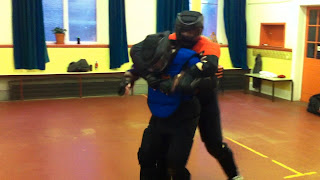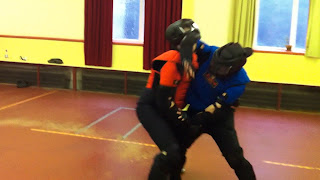Stress Exposure Training – Part 1
This is the first of a three-part series on Stress Exposure Training written by Ger O’Dea of Dynamis Training & Insight

Training people to deal with the stress of a violent confrontation can benefit from the methods used in some psychotherapy.
This article deals with the use of Stress Inoculation Training to guide Self-Protection and Physical Intervention trainers in the development of robust training programmes which will be resilient in the face of intense confrontations.
Stress is a process whereby environmental demands evoke an appraisal process in which perceived demand exceeds resources, and that results in undesirable physiological, psychological, behavioural or social outcomes.”
– Salas, Driskell and Hughes, 1996
Stress Inoculation Training (SIT) emerged out of an attempt to integrate the research on the role of cognitive and affective factors in coping processes with the emerging technology of cognitive behavior modification (Meichenbaum, 1977). SIT has been employed to help individuals cope with the aftermath of exposure to stressful events and sometimes it has even been used on a preventative basis to “inoculate” individuals to future and ongoing stressors.
In order to enhance individuals’ coping repertoires and to empower them to use already existing coping skills, the SIT model uses a three-phase approach.
SIT Phase One – Breaking Down the Problem
Regardless of the particular stressor which we are trying to prepare them to deal with, trainees are encouraged to view perceived threats and provocations as ‘problems-to-be-solved’ and to identify those aspects of some situations and their own reactions that are under their internal control and those aspects that are not under their control or influence.
This is the first step in breaking-down a stressor which at first seems overwhelming.
The clients are taught how to breakdown these ‘global stressors’ into specific short-term, intermediate and long-term coping goals. The trainees’ response to the stressor is re-packaged as being made-up of different components that have been identified and examined in detail. The trainee builds an understanding of each thing that needs to happen for the stressor to become overwhelming.
High-stress situations tend to go through predictable phases and so the trainee who will be successful should go through a process of preparing, building up, confronting, and reflecting upon their reactions to stressors also.
SIT Phase Two – Developing Skills to Deal with the Problem
The second phase of SIT requires focus on skills acquisition and rehearsal and it follows naturally from the initial conceptualization phase which came before it. The coping or confronting skills that are taught and practiced in the training setting are then gradually rehearsed ‘in vivo’ and are tailored to the specific stressors trainees may have to deal with.
SIT Phase Three – Exposure to the Problem
The final phase of training and preparation provides opportunities for the clients to apply the variety of skills they have learned to deal with the problem across increasing levels of intensity. This is where the inoculation concept – as used in medical immunization – becomes evident. Techniques such as imagery and behavioral rehearsal, modeling, role playing, and graded in vivo exposure in the form of “personal experiments” are used during this phase to increase the trainees competence.
Part 2 to follow…

 Spartan Training Gear‘s corporate allies, Dynamis Training and The Functional Edge System are teaming up for the first time to offer a BTEC Level 3 Advanced Award in Self Defence Instruction Program in Edinburgh, Scotland on July 27-29, 2011
Spartan Training Gear‘s corporate allies, Dynamis Training and The Functional Edge System are teaming up for the first time to offer a BTEC Level 3 Advanced Award in Self Defence Instruction Program in Edinburgh, Scotland on July 27-29, 2011